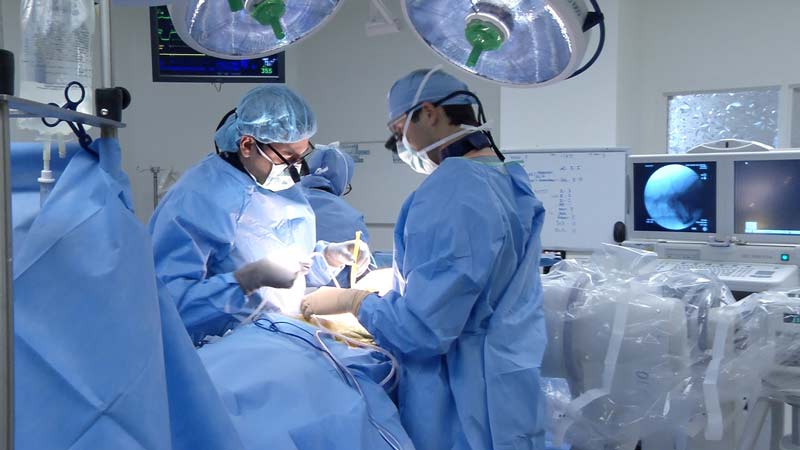When is surgery of the parathyroid glands needed?
If one or more of the parathyroid glands is too active or where parathyroid cancer is suspected (which is rare). The treatment of primary and tertiary hyperparathyroidism is surgery.
There are two types of treatment for parathyroid disorders. Traditional open parathyroidectomy surgery is performed through a neck incision where all four glands are identified and assessed. Alternately there is Minimally Invasive Parathyroidectomy surgery which is performed via a small incision together with PTH level testing allow for a more focused and less invasive procedure. Parathyroidectomy in general refers to removal of one or two abnormal parathyroid glands. Subtotal parathyroidectomy refers to removal of three and a half of the four glands. The half gland that remains is usually cut into small pieces and left in a neck muscle, where it can start working again usually after one to two months.
Traditional Parathyroid Surgery – Open Parathyroidectomy
 Parathyroidectomy is surgery to remove parathyroid glands or parathyroid tumours. The most common cause of primary hyperparathyroidism is a single parathyroid adenoma, which accounts for 80-90% of cases. The incision for parathyroid surgery is made in the front of the neck above the collar line. The parathyroid glands sit deep in the neck under the thyroid gland. One, two, three or all four parathyroid glands will be removed depending on the parathyroid disorder and glands enlarged. After removal of abnormal glands, parathyroid surgery is successful in up to 98% of patients. The incision is closed with dissolving sutures and most patients go home the day after surgery.
Parathyroidectomy is surgery to remove parathyroid glands or parathyroid tumours. The most common cause of primary hyperparathyroidism is a single parathyroid adenoma, which accounts for 80-90% of cases. The incision for parathyroid surgery is made in the front of the neck above the collar line. The parathyroid glands sit deep in the neck under the thyroid gland. One, two, three or all four parathyroid glands will be removed depending on the parathyroid disorder and glands enlarged. After removal of abnormal glands, parathyroid surgery is successful in up to 98% of patients. The incision is closed with dissolving sutures and most patients go home the day after surgery.
Minimally Invasive Parathyroidectomy – MIP
 MIP involves a small incision on one side of the neck – it is done when one abnormal gland is identified on preoperative testing. Around 90% of patients with primary hyperparathyroidism have an abnormality in one gland (parathyroid adenoma) and may be suitable for MIP. A Sestamibi scan or ultrasound can often find the abnormal gland which allows this one parathyroid gland to be removed though a small incision. Intra-operative rapid PTH testing is used to confirm the drop in the level of PTH hormone after the gland is removed. MIP has the advantage of a smaller incision and faster recovery – but not all patients are suitable for this approach
MIP involves a small incision on one side of the neck – it is done when one abnormal gland is identified on preoperative testing. Around 90% of patients with primary hyperparathyroidism have an abnormality in one gland (parathyroid adenoma) and may be suitable for MIP. A Sestamibi scan or ultrasound can often find the abnormal gland which allows this one parathyroid gland to be removed though a small incision. Intra-operative rapid PTH testing is used to confirm the drop in the level of PTH hormone after the gland is removed. MIP has the advantage of a smaller incision and faster recovery – but not all patients are suitable for this approach
Parathyroid Surgery Outcomes
Surgery to remove the enlarged gland (or glands) is the main treatment for the disorder and cures up to 98 percent of patients – most patients feel better as early as 72 hours after surgery. Interestingly, even those patients who are without symptoms, diagnosed with primary hyperparathyroidism based on blood tests only, usually find that they feel much better after surgery. When only one gland is removed, the remaining glands take over the job of calcium balance within a short period of time. Most patients go home the same day or next day after surgery and may resume eating and walking immediately after surgery.
Parathyroid Surgery Risks
-
Surgery for hyperparathyroidism is highly successful with a low complication rate
-
Occasionally the symptoms of low calcium levels develop after parathyroidectomy. Patietns are given detailed instructions about the symptoms of low calcium levels, (numbness and tingling around the lips and fingers, and muscle cramping) and know how to treat it immediately (usually by taking 2000mg of calcium supplements and at times Rocaltrol).
-
About 1 percent of patients undergoing surgery experience damage to the nerves controlling the vocal cords, which can affect speech
-
One to 5 percent of patients lose all their parathyroid tissue and thus develop chronically low calcium levels, which may require treatment with calcium or vitamin D – the complication rate is slightly higher for hyperplasia than it is for adenoma since more extensive surgery is needed.

